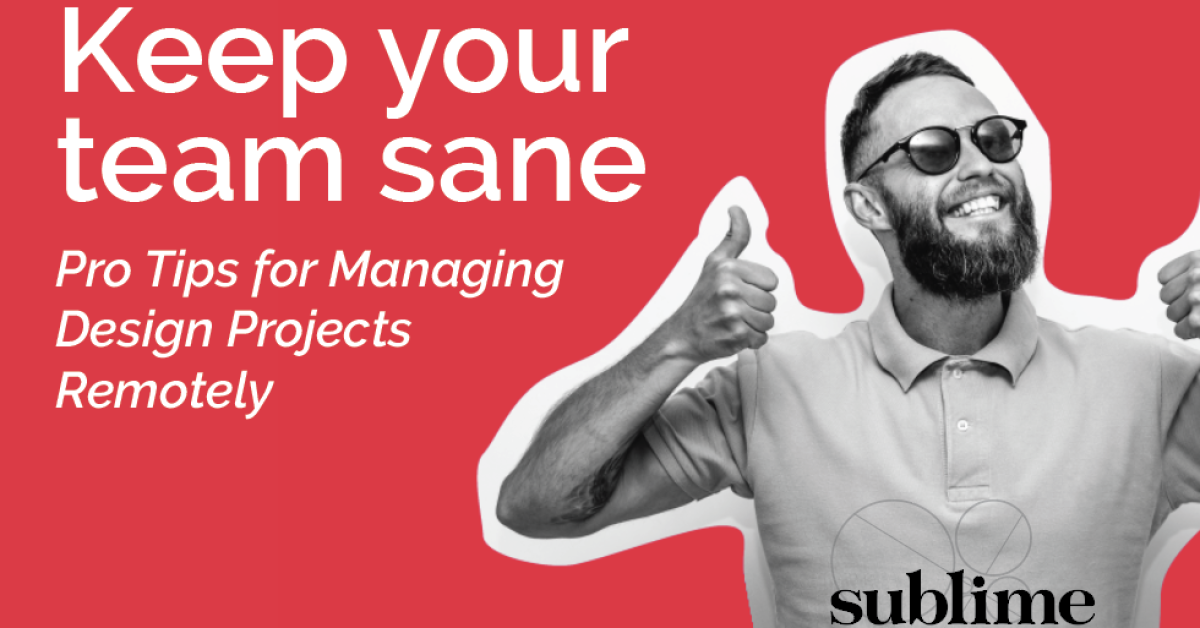Managing a project remotely isn’t easy, and it’s even harder when it’s a creative project with heavy visual components. Have you ever tried describing a painting in words? Or talking about your favorite design style without showing photos? If so, you know that it’s much harder to talk about design than it is to see it.
In an office setting, you can walk over to someone’s desk to see what they’re working on. Things get more complicated when you’re miles away from one another.
Sublime started as a fully remote company in 2002 and our team members are all over the country. It hasn’t always been easy making our projects run smoothly, but over the years we’ve landed on some simple best practices that make our projects easier to manage.
With stay at home orders extended in many states, now’s a great time to refine your WFH processes to make sure your projects continue to run smoothly whether you’re working from the couch or your office.
Get Everyone On Your Kickoff Call.
Complex creative projects often require a team of people to make them successful — writers, designers and managers. If you were in the office, you’d call a meeting to kick off the project and you should do the same with your remote projects. Get your entire team on a video call and walk through what to expect at each step of the way. Make sure everyone knows their role and the timeline.
Pro Tip: Encourage communication. Send an email with everyone copied and empower your team members to reach out to each other directly. This will allow each person to get the information they need quickly and easily.
Show, Don’t Tell.
When trying to explain what you want a design to look like, it’s always easier to show a visual example than it is to talk about it. Don’t have an example of what you want your design to look like? Pinterest is an awesome tool for this — we regularly create boards for new design projects and pin everything from color palettes to layout and imagery ideas. You can even have your colleagues collaborate and pin their ideas on a shared board.
Take FULL Advantage of Digital Tools to Track Your Project.
Many of you are already using digital tools to track projects. But are you using everything you can to simplify your process?
- Google Sheets — use shared sheets to track project progress and map out timelines. Everyone will always have access to the most up to date information and will know where to turn with questions about timing.
- Google Docs — use docs to add comments and collaborate on text in real time. Instead of emailing a document back and forth, you can all work on it at once.
- Asana / Basecamp / Workfront / Monday / Trello — assign tasks to individual collaborators and turn on notifications so you know when they’ve been completed.
Check In Along the Way With Screenshots.
With bigger projects, we often recommend that our designers check in along the way to share their progress. In the office you can stop by someone’s desk to check in on their progress, but that doesn’t work when you’re WFH. Check in along the way to make sure your team is headed in the right direction. Have your designer text, email or chat a screenshot when they have questions along the way.
Pro Tip: Connect your messaging apps to your laptop so you can easily get in touch with team members directly from your laptop and connect with urgent questions. This way you can send screenshots and get fast responses.
Compile All of Your Revisions in One Place. The fastest way to drive your design team crazy? Send all of your revisions in multiple messages or emails. Instead, find ways to compile all of your changes and send them at once. We use ProofHQ for digital proofing, allowing users to mark up designs and add comments with any edits they’d like. Using ProofHQ has made our lives so much easier that we now require it for most design projects. We’re more accurate with our edits and we don’t spend hours trying to decipher messy handwriting/scans or figuring out where on the page the edit needs to be made.
Pro Tip: Don’t have the budget for a digital proofing tool? No problem! Compile all your changes in a Google Doc and have your designer work from that doc. That way you’ll ensure no edits are missed in long email threads, and you’ll be able to add to the list in real time.
Get on a Screenshare to Finalize.
Got any major design edits? Jump on a screenshare and have your designer make the edits live. That way you can see what the design change will look like and talk through any additional edits that need to be made. We’ve found that we’re faster and also better at making design revisions when the designer is working live.
Once you implement some of these processes, we think you’ll find you’re saving time and keeping your team sane. Need additional advice? We’re always happy to help our colleagues when they need it. Just reach out and we’re happy to help.
